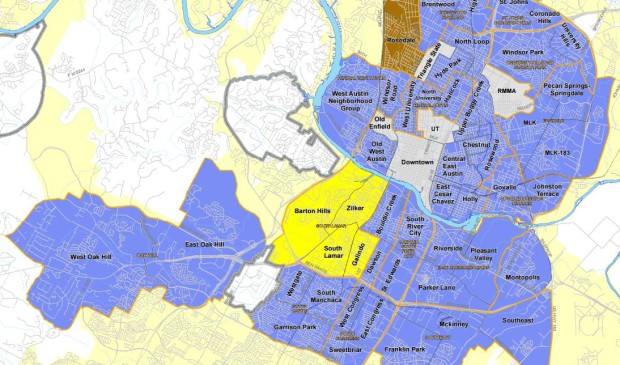Contact-team changes sail toward Council
Tuesday, January 19, 2016 by
Elizabeth Pagano This past fall, City Council asked for some uniformity and oversight for the city’s neighborhood-planning contact teams. And now, after hearing from stakeholders, those proposed changes are refined and on the way to becoming a reality.
The Planning and Zoning Department is now recommending that the city clarify the role of the contact-team bylaws template and create a complaint-based dispute-resolution process for contact teams. These recommendations are scaled back from the original proposal, which also would have taken a look at the geographical boundaries of the contact teams. Council dropped that proposal after it proved to be unpopular.
Last week, the Planning Commission approved the staff-proposed code amendments in a vote of 8-2, with commissioners Chito Vela and Michael Wilson voting in opposition. Chair Stephen Oliver and commissioners Jean Stevens and Patricia Seeger were absent for the vote.
“I really do think that this template and the way that this is written gives them enough of a structure to make sure that we’re being fair and consistent without micromanaging any of them,” said Commissioner Trinity White.
Vela appeared to disagree, saying he saw “a process that is very easily manipulated. … It’s very easy to stack votes.” In Vela’s view, the contact teams are a relic of an at-large Council, intended to be “a way to give the neighborhoods a voice.”
Contact teams are neighborhood groups that set priorities in their neighborhood plans, initiate plan amendments and make recommendations to staff about those plan amendments, among other things. In addition, the groups receive notice when plan amendments are proposed and generally weigh in on those proposals, as they have a deeper working knowledge of their neighborhood plans than most residents.
Unlike neighborhood associations, contact teams are regulated by the city and prohibited from collecting dues, but some of the groups’ functions do overlap. Currently, there are 31 contact teams in Austin, and they cover about 42 percent of the city’s population. The teams include representation from homeowners, renters, businesses and organizations that are within the planning area, and they submit a list of officers, members and bylaws to the city on an annual basis.
“I’m not sure what our goal is with this whole neighborhood-planning contact-team process,” said Vela. “People are absolutely able and willing, as we see, to come here in groups and let us know exactly what they think about whatever it is we are doing.”
“I’m concerned with the whole process, conceptually,” said Vela.
White pointed out that many of groups the commission heard from were, in fact, contact teams, and that many neighborhoods lacked associations that did the work of contact teams. “Some of them are really small, some are really large. … It really depends,” she said. “I think the neighborhood-planning contact teams are just another way for you to get involved in your city government and get involved in the conversation. … I think we should be encouraging those types of outlets.”
Commissioner Fayez Kazi said that in his experience as an officer of a contact team, “there was plenty of opportunity to manipulate,” given the small attendance numbers and lack of resources to reach out to people in the planning area. “But that’s just one contact team,” he said. “It doesn’t mean much.”
“I think there’s room for improvement, but that’s what this is,” said Kazi.
In conjunction with recommending the code amendments, Planning and Zoning Department staff also propose to identify a staff position and Web platform to develop a website for contact-team info and develop a contact-team orientation manual and materials. They suggest that Council check in on the status of the improvements by December of this year.
Zilker neighborhood resident David King said he was glad to see a conversation about how to help the neighborhood-planning process.
“We do need to have a well-planned, well-thought-out planning process for neighborhoods and contact teams,” said King. “It needs work. And the neighborhoods need help.”
King suggested a city department that focused only on neighborhoods could be a resource for contact teams and others.
Reid Long, who is a member of the Hyde Park neighborhood contact team, spoke on his own behalf in support of the code amendments. He highlighted the lack of staff availability for contact teams, especially in terms of Web development. Long said his team would like to provide more information online but doesn’t have the resources to do so and is prevented by city code from raising money to pay for those resources.
The Planning and Neighborhoods Committee will weigh in on the proposed changes at its meeting today, and the matter is currently scheduled for the Jan. 28 meeting of Council.
Map of contact-team boundaries courtesy of the city of Austin.
You're a community leader
And we’re honored you look to us for serious, in-depth news. You know a strong community needs local and dedicated watchdog reporting. We’re here for you and that won’t change. Now will you take the powerful next step and support our nonprofit news organization?








